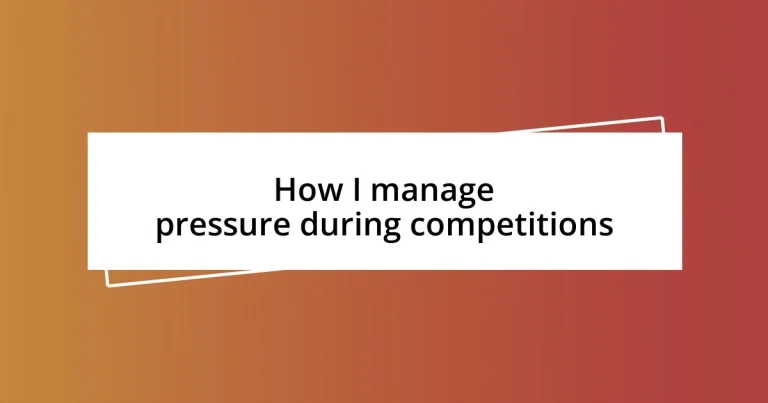Key takeaways:
- Understanding and managing pressure can transform competition experiences, shifting from fear to excitement and motivation.
- Developing a consistent mental preparation routine, including visualization and breathing techniques, enhances focus and calmness under pressure.
- Reflecting on performances and building a supportive network fosters resilience and continuous improvement, normalizing experiences in high-pressure situations.
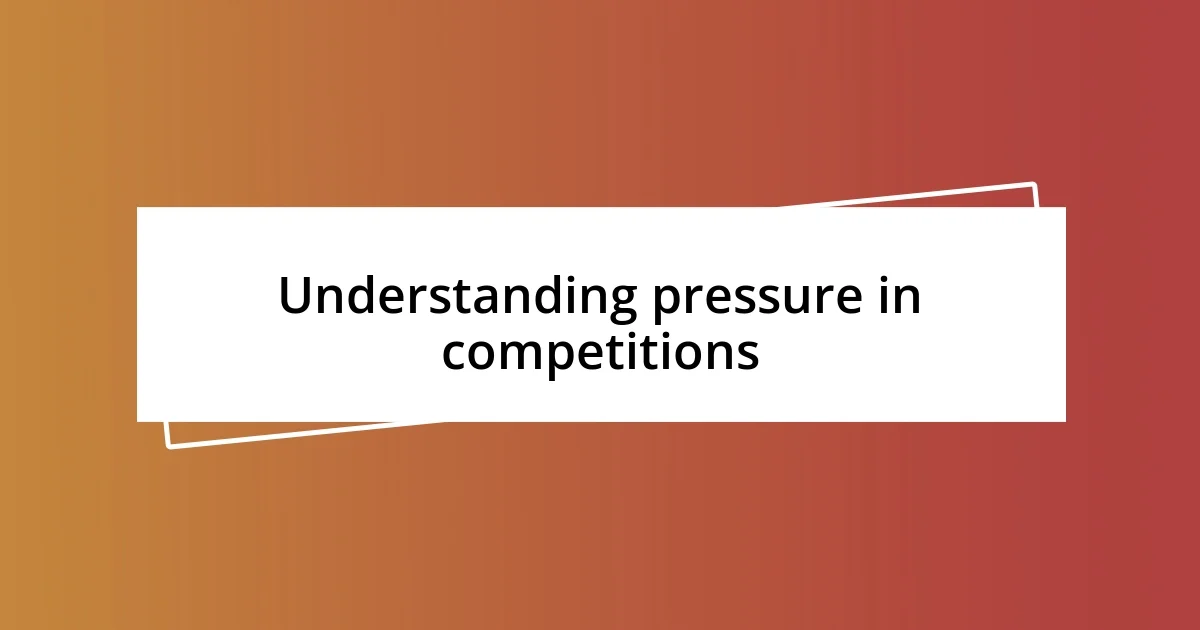
Understanding pressure in competitions
Understanding pressure in competitions is fascinating yet complex. For me, the pressure often feels like a heavy weight pressing down just before I start. It’s that surge of adrenaline mixed with fear of failure—something I believe many of us experience in high-stakes situations. Why do we let societal expectations and personal goals create such intense feelings?
Reflecting on my experiences, I remember a particularly challenging moment during a competition where I was convinced I’d stumble. My heart raced, and my palms were sweaty. I realized then that pressure isn’t just an external factor; it can also arise from within—our inner critic can be relentless, can’t it? Acknowledging that I was in charge of my thoughts helped me shift my focus from fear to excitement about showcasing my skills.
Interestingly, I’ve found that pressure can also be a powerful motivator. A few years back, during a pivotal event, I channeled my nerves into performance. I saw pressure as a driving force—a chance to push my limits. Isn’t it empowering to realize that what we often perceive as a burden can also propel us to new heights? Understanding this duality of pressure has reshaped my approach to competitions.
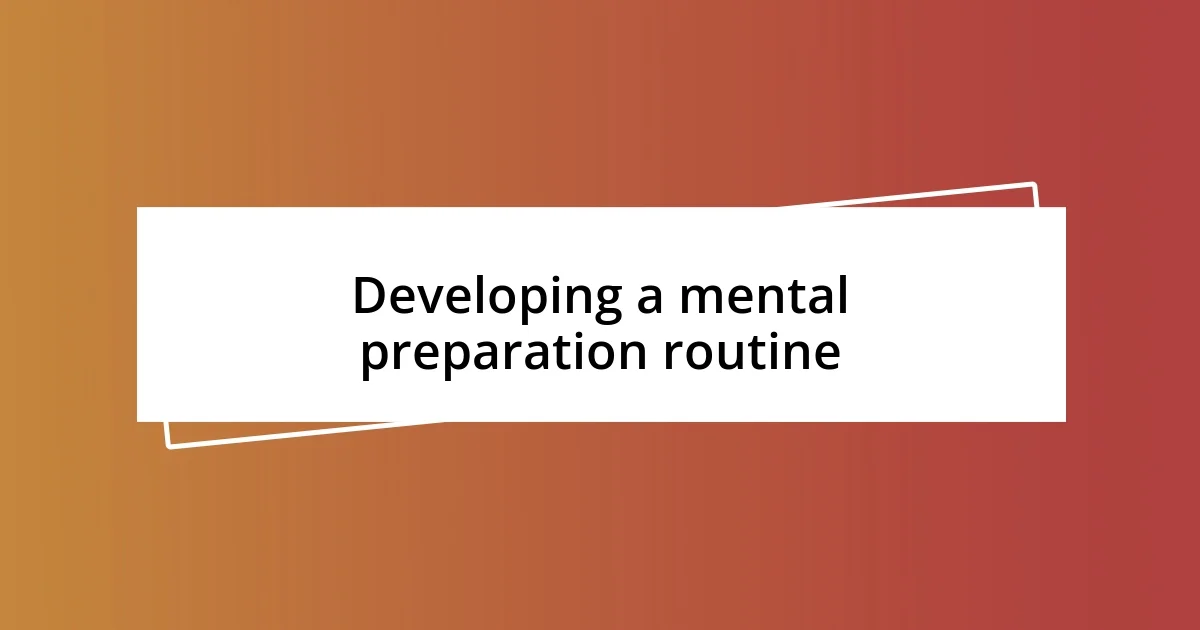
Developing a mental preparation routine
To develop a mental preparation routine, I’ve found that it’s crucial to create a consistent practice that centers me before competition. Visualizing success has become an essential part of my approach. I often imagine the moment I step on stage or into the ring, allowing myself to feel the positive energy and confidence. This small ritual helps me quell my nerves and align my focus. It’s like having a secret weapon in my mental toolbox.
Here are some practical steps to consider when crafting your own routine:
- Set a specific time for your routine before each competition to create habit and familiarity.
- Use visualization techniques, picturing your ideal performance in vivid detail.
- Incorporate mindfulness practices like deep breathing or meditation to center your thoughts.
- Reflect on past successes, reminding yourself of times you overcame pressure and performed well.
- Create positive affirmations that resonate with you, reinforcing your capabilities and combating negative self-talk.
For me, these methods have transformed an overwhelming experience into an empowering one, allowing me to enter competitions ready to take on whatever challenge comes my way. It’s all about building that mental fortress, brick by brick, so when the heat is on, I feel calm and prepared.
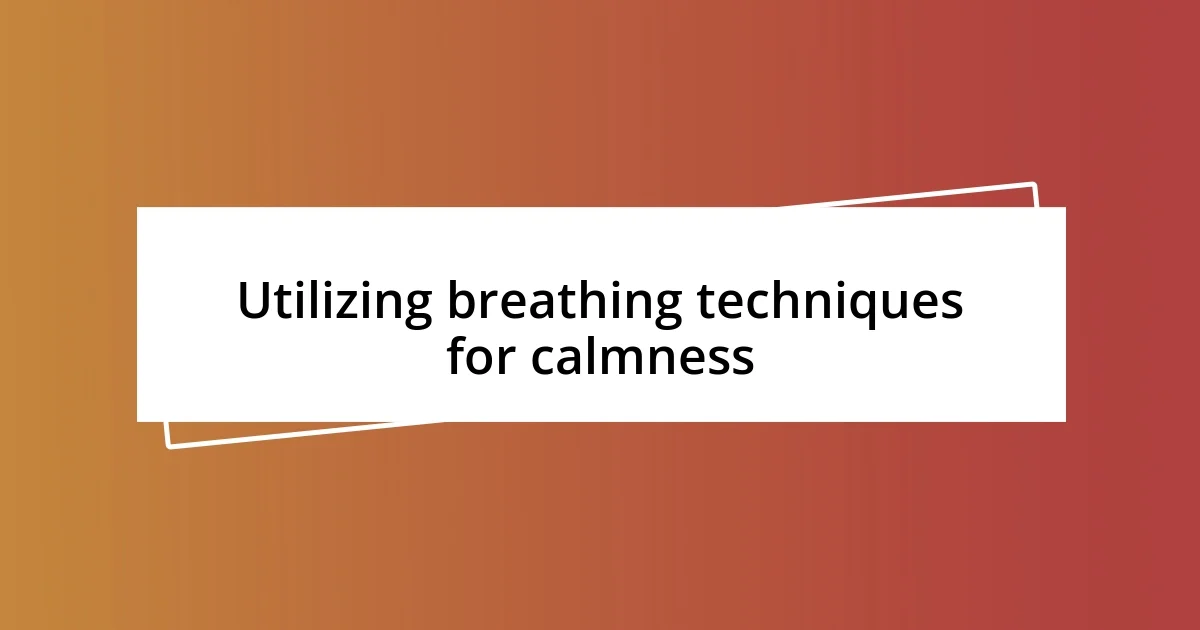
Utilizing breathing techniques for calmness
Utilizing breathing techniques can make a world of difference when managing pressure during competitions. I’ve often relied on deep breathing exercises to help ground myself in those anxious moments. For instance, just before stepping onto the mat, I take a few moments to inhale deeply through my nose, holding the breath for a few seconds, and exhaling slowly through my mouth. This process not only calms my racing heart but also clears my mind, allowing me to focus solely on the task ahead.
In challenging moments, I remind myself of the “4-7-8” breathing technique, where I inhale for four seconds, hold for seven, and exhale for eight. Surprisingly, this simple exercise transforms the chaos in my mind into a serene calmness. Once, before a big event where the stakes were high, I could feel the pressure mounting. By implementing this technique, I felt my anxiety shift into a positive energy that fueled my performance. It’s as if I took control of my body’s response and turned it into something productive.
Interestingly, I’ve discovered that practicing these techniques before the competition becomes a crucial part of my routine. In fact, the more consistently I utilize these breathing exercises, the more effective they become. It’s like training a muscle; the more you work at it, the stronger it gets. In those moments of pressure, breathing isn’t just about air—it’s about harnessing calmness, clarity, and confidence.
| Breathing Technique | Description |
|---|---|
| Deep Breathing | Inhale deeply through the nose, hold for a few seconds, and exhale slowly through the mouth to calm the mind and body. |
| 4-7-8 Technique | Inhale for 4 seconds, hold for 7, and exhale for 8 to alleviate anxiety and refocus energy. |
| Mindful Breathing | Focus solely on the breath, allowing distractions to fade, helping to ground oneself in the moment. |
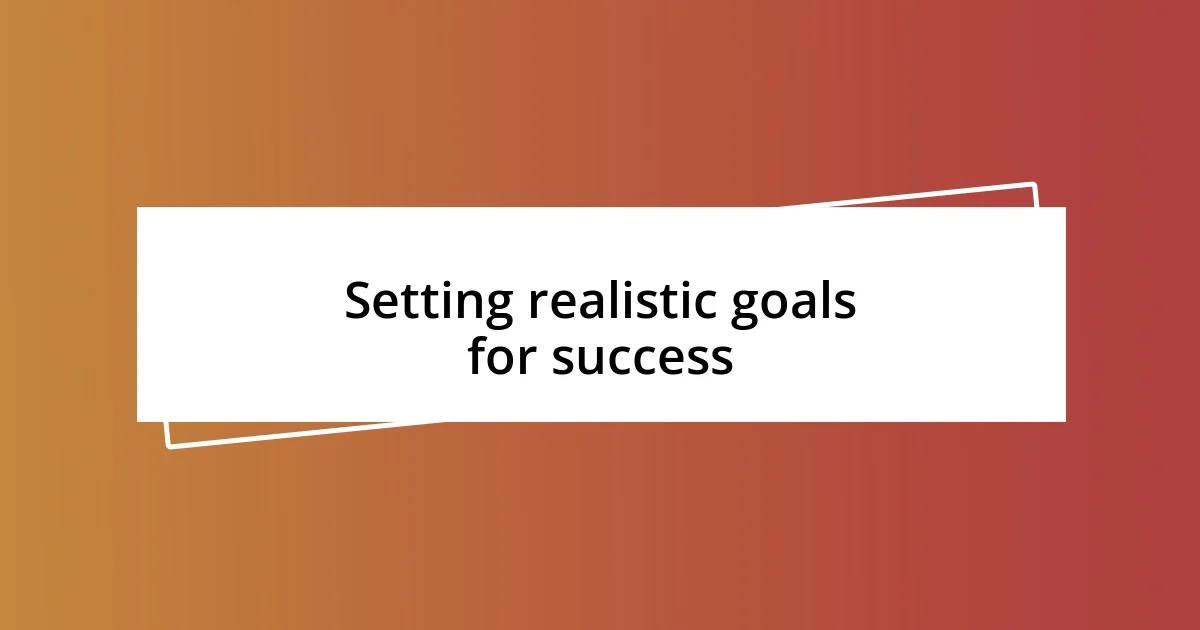
Setting realistic goals for success
Setting realistic goals is fundamental to achieving success in any competition. From my own experience, I learned that if my goals are too lofty, they often lead to unnecessary pressure and disappointment. Instead, breaking down my aspirations into bite-sized, achievable targets has made a significant difference. For example, rather than aiming to win a championship outright, I focus on improving one specific skill for each competition. This shift in perspective not only alleviates anxiety but also allows me to celebrate small victories along the way.
I sometimes wonder: how many times do we set ourselves up for failure by expecting too much, too soon? I recall a pivotal moment in my career when I aimed for a personal best in my performance but overlooked the importance of growth. Focusing instead on mastering the fundamentals brought me greater satisfaction and gradual improvement. It’s an interesting journey to embrace the process rather than becoming fixated solely on the end result.
Having a clear vision of my goals creates an empowering structure—it’s like having a roadmap in unfamiliar territory. There were times I caught myself feeling overwhelmed by the larger picture. I learned to hone in on the day-to-day objectives, which consistently nudged me toward success without feeling burdened. When I set these realistic benchmarks, I find that I am more resilient in the face of challenges. Instead of feeling defeated by setbacks, I view them as critical feedback that propels my growth forward.
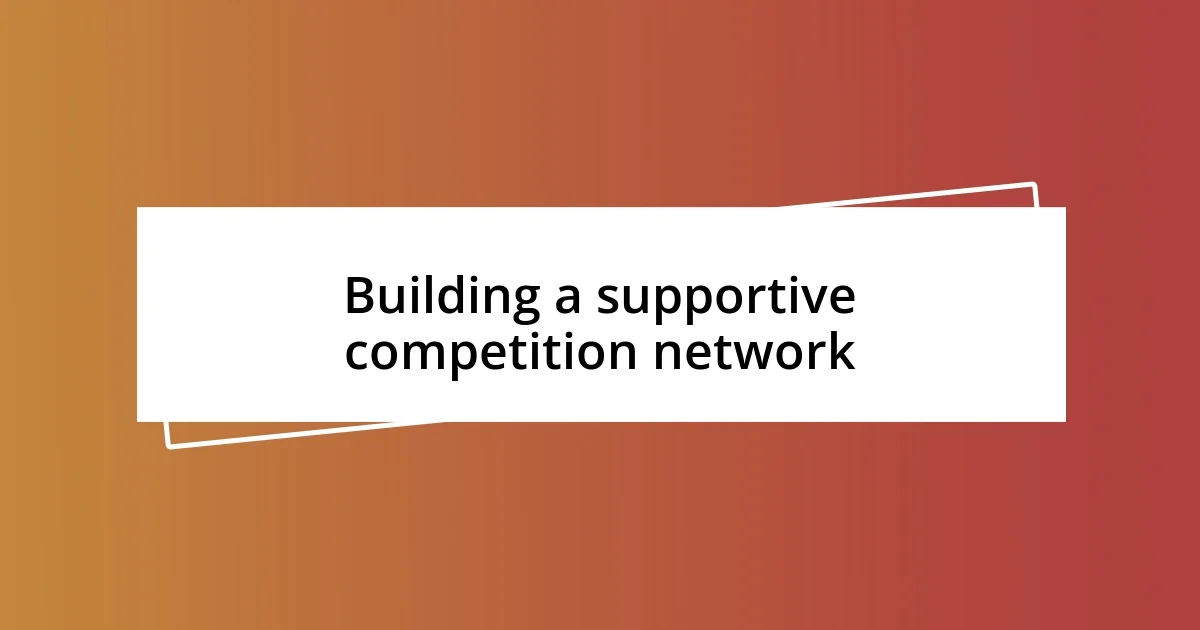
Building a supportive competition network
Building a supportive competition network has been a game-changer in how I handle pressure. I vividly remember the moments when I felt overwhelmed during competitions, looking around and realizing I wasn’t alone. Connecting with fellow competitors, coaches, and mentors has not only provided me with encouragement but also actionable advice during crucial times. Isn’t it comforting to know that someone else understands your struggles? The camaraderie that develops in these relationships can act as a safety net, helping me bounce back from disappointments and share in the triumphs.
The beauty of having a strong network lies in the diverse perspectives they offer. In one memorable instance, I reached out to a teammate who had faced similar nerves before big events. Our conversations revealed techniques that worked for her, which I later incorporated into my routine. I felt a wave of relief wash over me; it was refreshing to know I wasn’t reinventing the wheel alone. These exchanges create an enriching environment where we uplift each other, transforming competitive pressure into collective motivation.
Moreover, the emotional support I gain from this network cannot be overstated. I’ve had days when self-doubt crept in, but just hearing a teammate share that they faced the same feelings helped normalize my experience. This sense of belonging has fostered resilience in me; I learned that instead of viewing competition as a solitary battle, it’s a shared journey. Isn’t it fascinating how the support of even one person can change your entire outlook? I now actively seek out those connections, knowing they can turn challenging moments into opportunities for growth and friendship.
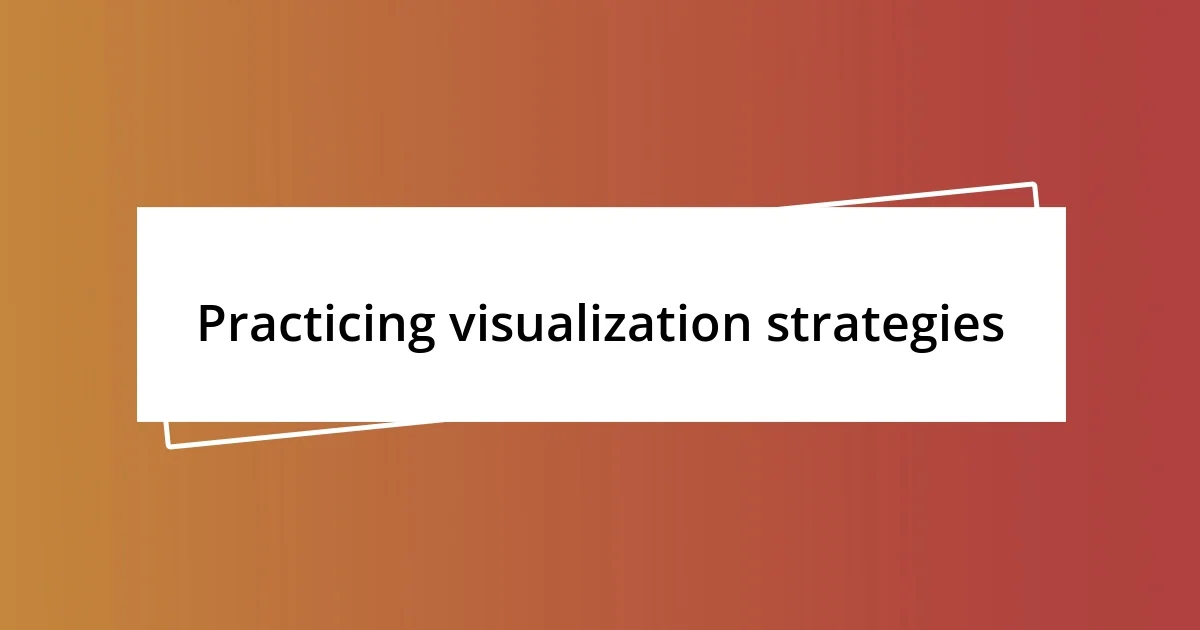
Practicing visualization strategies
Practicing visualization strategies has been a transformative technique in managing pressure during competitions for me. I vividly recall standing backstage before a major performance, my heart racing and nerves creeping in. Instead of allowing those feelings to take over, I closed my eyes and visualized myself executing each movement flawlessly. This mental rehearsal didn’t just calm my nerves; it created a sense of familiarity that made the actual performance feel like a natural extension of my practice. Have you ever imagined a successful outcome in your mind? It can truly make all the difference.
One particular instance stands out when I faced my biggest competition yet. In the weeks leading up to the event, I dedicated time to visualizing every scenario—from nailing my routines to handling unexpected hiccups. By picturing myself succeeding in high-pressure moments, I felt a significant shift in my mindset. It’s as if I moved from viewing competitions as daunting challenges to exciting opportunities. Visualizing my success made me feel more in control, as though I had already lived through the experience and emerged victorious. This process has continually taught me that our minds are powerful tools; what we envision can indeed become our reality.
I also find it beneficial to incorporate breathing techniques into my visualization practice. While visualizing my performance, I take deep breaths, allowing myself to feel each inhale and exhale, grounding me in the present moment. I often ask myself: how can I harness this moment to enhance my focus? This combination helps eliminate distractions and heightens my concentration. Through this simple yet effective technique, I’ve learned that managing pressure is not about eliminating nerves but rather embracing and redirecting them into positive energy. Isn’t it fascinating how a few moments spent in quiet visualization can transform the chaos of competition into a symphony of possibility?
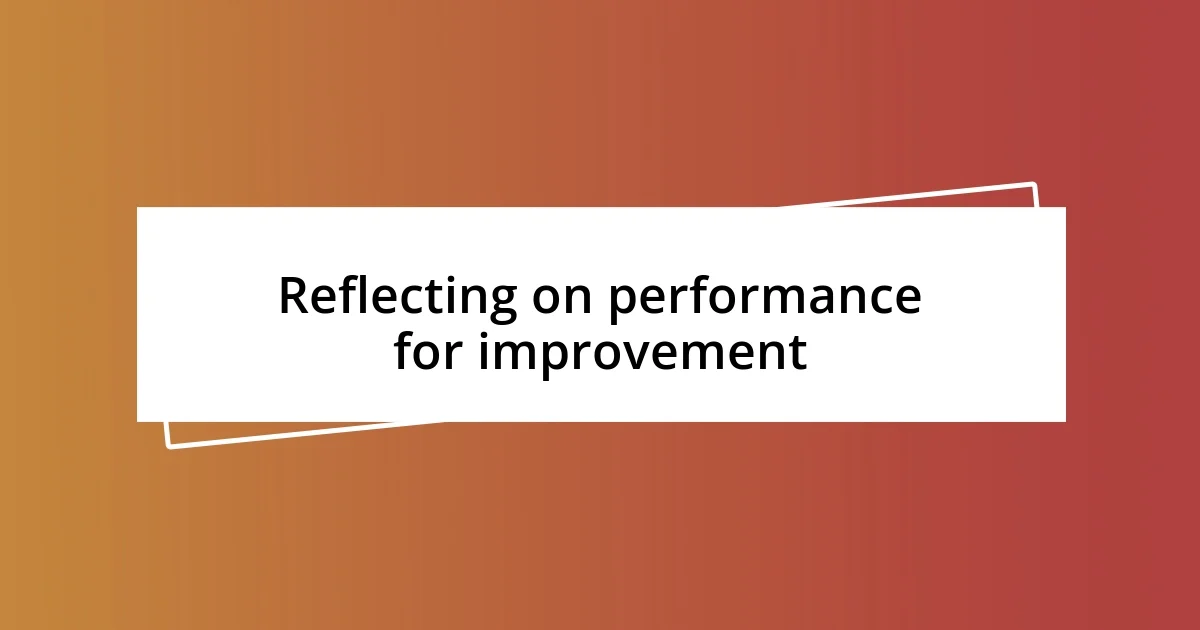
Reflecting on performance for improvement
Reflecting on performance is a crucial step that has significantly influenced my journey in maintaining composure during competitions. After each event, I take time to analyze not just my outcomes but also my reactions and emotions throughout the experience. I recall a specific competition where I struggled with my focus, and upon reflection, I realized that certain triggers had thrown me off my game. How often do we overlook our mental state amidst the chaos? That awareness allowed me to identify those distractions for the future.
I often jot down my thoughts in a journal, documenting my feelings and any distractions that arose during the competition. This practice has become a valuable resource for my growth. For example, after a recent performance, I noted that I felt overwhelmed by the crowd’s energy at one moment, which led to a small mistake. Reflecting on this, I’ve actively worked on strategies to better channel that energy instead of letting it overtake me. Isn’t it intriguing how self-reflection can unveil patterns we never knew existed? This clarity fosters a deeper understanding of how I operate under pressure.
Moreover, I’ve learned that discussing my performances with trusted peers provides additional insights that my own reflections may miss. I recall a post-event debriefing with a friend, where we shared our individual experiences. They pointed out how I seemed to shine in moments of adversity, an observation that made me appreciate my resilience. How often do we recognize our strengths? Engaging in these conversations not only helps solidify my learnings but also reinforces the importance of community in this journey. It’s truly enlightening to discover new facets of ourselves through the lens of others’ perspectives.












